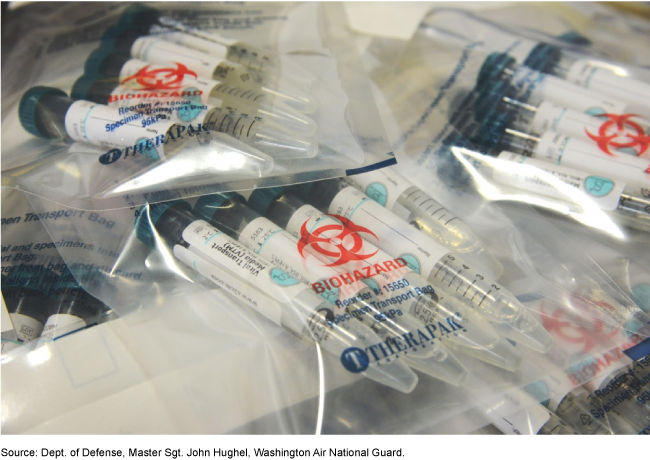COVID-19: Defense-Wide Working Capital Fund Cash Management and Defense Logistics Agency Pandemic Response
Fast Facts
The Department of Defense received $500 million for a working capital fund to respond to the COVID-19 pandemic.
The Defense Logistics Agency (DLA) used the funding to help respond to a surge in demand for medical supplies from both DOD and non-DOD customers. FEMA and Health and Human Services—the federal government's lead agencies for pandemic response—were DLA's largest customers for COVID-related items.
From March 2020-May 2021, DLA funded $3.67 billion in contracts for test kits, N95 respirators, and more.

Highlights
What GAO Found
Three Department of Defense (DOD) agencies, including the Defense Logistics Agency (DLA), use the Defense-Wide Working Capital Fund (DWWCF) to fund their operations and then deposit the proceeds from sales of goods and services to their customers back into the fund. DOD received $500 million from the Coronavirus Aid, Relief, and Economic Security Act (CARES Act) for the DWWCF in order to position the agency to respond to the Coronavirus Disease 2019 (COVID-19) pandemic. GAO found:
DOD Actions Helped Maintain DWWCF Balances within Targeted Ranges. Several transactions increased the DWWCF cash balances. In particular, the DWWCF received nearly $600 million in allotments from appropriations from January 2020 through January 2021, including $500 million from the CARES Act. DLA, which uses the DWWCF to fund operations, such as providing consumable items and fuel to its military customers and other federal agencies, also received $2 billion in advance billings from the Department of Health and Human Services (HHS) and Federal Emergency Management Agency (FEMA) from April 2020 through September 2020. DOD officials said they also took actions that had the effect of mitigating the extent to which DWWCF cash balances exceeded the targeted upper cash requirement. DOD transferred $241 million to military services' working capital funds and reduced fuel prices by 20 percent, among other things. DLA officials said that they expect the $3.6 billion cash balance to decline as advance-billed orders are filled and fuel prices recover.
DLA Responded to a Surge in Medical Materials Demand during the Pandemic. From March 2020 through May 2021, DLA executed about 31,000 contract actions marked as COVID-19–related, resulting in $3.67 billion in contract obligations. DLA officials said FEMA and HHS became DLA's largest customers for COVID-19–related items during the pandemic. COVID-related procurements included test kits, gloves, N95 respirators, hand sanitizers, surgical masks, ventilators, and protective gowns, among other things.
DLA Did Not Plan for Pandemic Support, but It Tracked Performance and Identified Lessons Learned. DLA officials told GAO they were not tasked with planning to support civilian agencies in a pandemic, and they had not developed plans for supporting other federal agencies during a pandemic prior to the current pandemic. However, DLA continued to monitor and measure its medical supply chain performance during the pandemic using previously established measures, which showed that its performance decreased during the pandemic. Officials from DLA and from its customer agencies attributed this decrease to difficulties experienced by vendors in responding to medical material demand during the global pandemic.
DLA Increased Medical Contracting and Reduced Contracting in Some Other Areas. GAO's analysis found that DLA obligated $40.1 billion on contracts from March 2020 through February 2021, a decrease of more than $2.0 billion (4.8 percent) as compared with the same 12-month period prior to the pandemic. DLA obligations increased in 64 of 134 product service groups, with the largest increases occurring in the medical, dental, and veterinary equipment and supplies; firefighting, rescue, and safety equipment and environmental protection equipment and materials; and instruments and laboratory equipment groups. DLA obligations decreased in 69 of 134 product service groups, with the largest decreases occurring in the fuels, lubricants, oils and waxes and the aerospace craft components and accessories product service groups.
Of the 11,832 DLA vendors used during this period, GAO found that DLA obligations related to 6,208 (52.5 percent) decreased, 4,960 (41.9 percent) increased, and 664 (5.6 percent) had no change. DLA obligations related to vendors providing medical, dental, and veterinary equipment and supplies had the largest increases, and obligations related to those providing fuels, lubricants, oils, and waxes and those providing aerospace components had the largest decreases. The decreases did not significantly alter the proportion of DLA contracting obligations going to vendors in three primary socioeconomic groups (small disadvantaged, women–owned, and minority–owned).
Why GAO Did This Study
This report responds to a request from the Readiness Subcommittee of the House Armed Services Committee that GAO review DOD's management of the DWWCF cash balance and DLA's response to the COVID-19 pandemic, and it is part of GAO's body of work in response to the CARES Act. This report provides information on: (1) actions DOD took from October 2018 through March 2021 to maintain the DWWCF cash balance between its targeted upper and lower cash requirements; (2) the effects of the pandemic on DLA's supply chain management activity, including medical supplies, starting in March 2020; (3) DLA's planning to support a pandemic event and tracking of its performance in meeting customer needs from March 2020 through June 2021; and (4) changes in DLA's contracting activity, by type of product and individual vendor, from March 2019– February 2020 and March 2020–February 2021. GAO reviewed DWWCF cash balances and budget estimates; DLA readiness reports and performance measures; and federal contracting data; and interviewed officials of DLA and its customers.
For more information, contact Elizabeth A. Field at (202) 512-2775 or fielde1@gao.gov.
